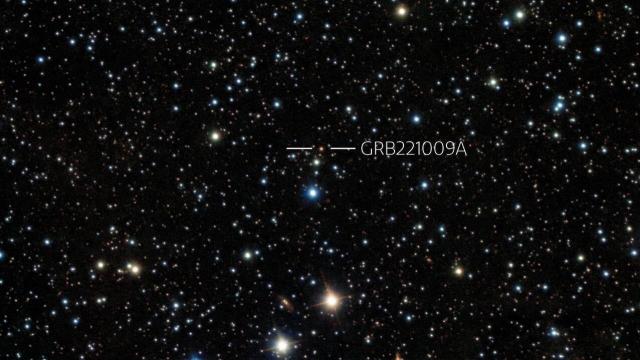Astronomers have detected a big boom in the distant universe that they believe may be the most powerful explosion ever recorded. It’s already got a nickname: ‘BOAT,’ or the Brightest Of All Time.
The explosion was a gamma-ray burst that scientists believe was triggered by a supernova, or the death of a star, that gave way to a black hole. The event, named GRB 221009A, was seen by the Gemini South telescope in Chile, operated by the National Science Foundation’s NOIRLab.
Because the event has only just been observed, scientists have yet to run thorough analyses of it. But this is what we know: It occurred about 2.4 billion light-years away and was first detected on the morning of October 9 by several X-ray and gamma-ray space telescopes.
Today, the FLAMINGOS-2 imaging spectrograph and the Gemini Multi-Object Spectrograph collected observations, meaning that two independent teams of astronomers now have recorded data on the event.
“The exceptionally long GRB 221009A is the brightest [gammy-ray burst] ever recorded and its afterglow is smashing all records at all wavelengths,” said Brendan O’Connor, a researcher affiliated with the University of Maryland and George Washington University and one of the team’s leaders, in a NOIRLab release.
“Because this burst is so bright and also nearby, we think this is a once-in-a-century opportunity to address some of the most fundamental questions regarding these explosions, from the formation of black holes to tests of dark matter models,” O’Connor added.
When stars die, they often illuminate the cosmos in extremely bright supernovae — literally the ejection of their mass into space after an epic implosion. Sometimes these events leave behind neutron stars, some of the densest objects in the universe. Other times, the result is a black hole.
When a black hole forms, it pushes out superheated particle jets that can move at nearly the speed of light. When pointed at Earth, the jets can be observed in X-rays and gamma rays.
Jillian Rastinejad, a researcher at Northwestern University and the leader of the other team, said in the NOIRLab release that the gigantic event is already being referred to as the ‘BOAT,’ or the Brightest Of All Time.
Though the superlative nature of the gamma-ray burst has yet to be confirmed, it’s clear that whatever happened 2.4 billion light-years from Earth was a ginormous explosion. The haste with which astronomers managed to image the event after its initial detection is a testament to the importance of sharing information across astronomical teams and observatories.
It also shows how important it is for observatories to keep their eyes on the sky. Soon, the Vera Rubin Observatory camera — the largest digital camera ever built, with 3.2 billion pixels — will begin its surveillance of the sky. It will be able to scan the entire sky once a week, like an astronomical Eye of Sauron. Any happenings of astronomical intrigue will be immediately recorded, and teams around the world will receive alerts. In this way, astronomers will be able to take note of serious bombastic events, no matter how fleeting. Whether any event can compare to the BOAT, well, we’ll have to wait and see.
More: Astronomers May Have Spotted the Remnants of One of the Earliest Stars
